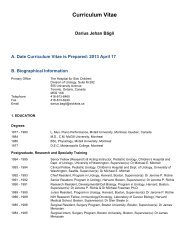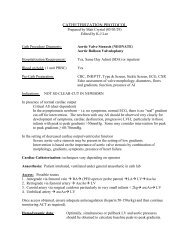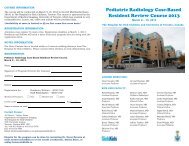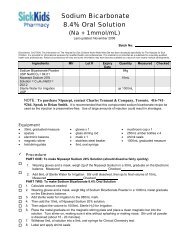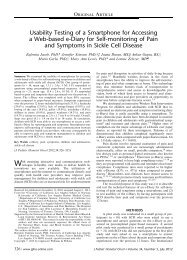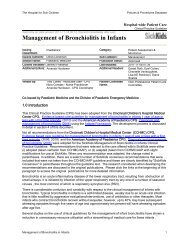Neuronal plasticity: A link between stress and mood disorders
Neuronal plasticity: A link between stress and mood disorders
Neuronal plasticity: A link between stress and mood disorders
You also want an ePaper? Increase the reach of your titles
YUMPU automatically turns print PDFs into web optimized ePapers that Google loves.
Stress, neurotrophic factors <strong>and</strong> depression S209<br />
4. BDNF: a neurotrophin with multiple sites of regulation . . . . . . . . . . . . . . . . . . . . . . . . . . . . . . . . . . . . S210<br />
5. Neurotrophic factors in depression. . . . . . . . . . . . . . . . . . . . . . . . . . . . . . . . . . . . . . . . . . . . . . . . . S211<br />
6. Modulation of BDNF expression by <strong>stress</strong> . . . . . . . . . . . . . . . . . . . . . . . . . . . . . . . . . . . . . . . . . . . . . S211<br />
7. Modulation of BDNF by antidepressant treatment . . . . . . . . . . . . . . . . . . . . . . . . . . . . . . . . . . . . . . . S212<br />
8. Antidepressant treatment modulate <strong>stress</strong>-induced changes of BDNF . . . . . . . . . . . . . . . . . . . . . . . . . . . S212<br />
9. Concluding remarks . . . . . . . . . . . . . . . . . . . . . . . . . . . . . . . . . . . . . . . . . . . . . . . . . . . . . . . . . . S214<br />
References . . . . . . . . . . . . . . . . . . . . . . . . . . . . . . . . . . . . . . . . . . . . . . . . . . . . . . . . . . . . . . . . S214<br />
1. <strong>Neuronal</strong> <strong>plasticity</strong> <strong>and</strong> psychiatric illness<br />
<strong>Neuronal</strong> <strong>plasticity</strong> refers to the ability of the nervous system<br />
to respond <strong>and</strong> adapt to environmental challenges <strong>and</strong><br />
encompasses a series of functional <strong>and</strong> structural mechanisms<br />
that may lead to neuronal remodelling, formation of<br />
novel synapses <strong>and</strong> birth of new neurons. However, in a<br />
broader sense, neuronal <strong>plasticity</strong> is intimately <strong>link</strong>ed to<br />
cellular responsiveness <strong>and</strong> may therefore be considered<br />
an index of the neuronal capability to adapt its function to<br />
a different dem<strong>and</strong>. Failure of such mechanisms might<br />
enhance the susceptibility to environmental challenges, such<br />
as <strong>stress</strong>, <strong>and</strong> ultimately lead to psychopathology. That is to<br />
say that the brain, or more specifically, some brain structures<br />
or circuits, may become more vulnerable by loosing progressively<br />
(or suddenly) the ability to adapt <strong>and</strong> maintain their<br />
homeostasis. The manifestation of such vulnerability can be<br />
quite different according to the pathologic condition <strong>and</strong><br />
may lead to overt degeneration (as occurring in neurodegenerative<br />
<strong>disorders</strong>) or to more subtle changes, leading to<br />
functional impairment, which represents a feature of psychiatric<br />
illness.<br />
During the last few years it has indeed become apparent<br />
that several psychiatric conditions, such as <strong>mood</strong> <strong>disorders</strong>,<br />
are associated with deficits or impairment of neuronal <strong>plasticity</strong><br />
(Castren, 2005; Krishnan <strong>and</strong> Nestler, 2008; Pittenger<br />
<strong>and</strong> Duman, 2008). Although for many years depression has<br />
been <strong>link</strong>ed to abnormalities in monoaminergic neurotransmission,<br />
it is now well accepted that this condition is characterized<br />
by profound alterations of brain function <strong>and</strong><br />
responsiveness. Hence depressed subjects display an inability<br />
to cope or adapt to the environment <strong>and</strong> may be more<br />
vulnerable to challenging experiences. These abnormalities<br />
may be intimately <strong>link</strong>ed with neuronal <strong>plasticity</strong> <strong>and</strong> the<br />
ability to modulate a cascade of events from intracellular<br />
signaling mechanisms to gene expression.<br />
Although the individual susceptibility threshold to environmental<br />
events may be genetically determined, it is believed<br />
that life events occurring during brain development may be<br />
critical for later psychopathology. Traumatic experiences<br />
occurring early in life may herein disrupt the correct program<br />
of maturation <strong>and</strong> eventually impact on brain function leading<br />
to a deterioration of neuronal <strong>plasticity</strong>. Indeed the brains of<br />
depressed subjects show structural abnormalities <strong>and</strong> reduced<br />
expression of several markers for neuronal function <strong>and</strong> viability,<br />
among which neurotrophic factors seem to be playing a<br />
pivotal role (aan het Rot et al., 2009; Sheline et al., 2003).<br />
These new concepts imply a reconsideration of the<br />
mechanisms that may be relevant for clinical achievements.<br />
In agreement with the well-known delay for therapeutic<br />
responses, psychotropic drugs, should be able to restore<br />
these defective systems around a physiological set point in<br />
order to alleviate symptoms <strong>and</strong> reduce the susceptibility to<br />
environmental challenges. In a word, these treatments might<br />
contribute to maintain stability.<br />
We will discuss neuronal <strong>plasticity</strong> in the context of <strong>stress</strong>related<br />
situations <strong>and</strong> <strong>mood</strong> <strong>disorders</strong> by focusing on neurotrophic<br />
factors, <strong>and</strong> in particular the neurotrophin brainderived<br />
neurotrophic factor (BDNF), although several other<br />
mechanisms should also be taken into account, since most of<br />
these systems are interrelated <strong>and</strong> may represent different<br />
facets of the same condition.<br />
2. Stress <strong>and</strong> susceptibility to <strong>mood</strong><br />
<strong>disorders</strong><br />
Stress represents the major precipitating factor in <strong>mood</strong> <strong>disorders</strong>.<br />
It may be inferred that affected subjects have a<br />
different threshold for <strong>stress</strong> susceptibility, which means that<br />
mechanisms that are required to cope with <strong>stress</strong> can be<br />
altered or less functional. The effects of <strong>stress</strong> on brain<br />
function depend on the timing <strong>and</strong> duration of the adverse<br />
experience. As already mentioned, adverse events early in life<br />
can be particularly relevant for later psychopathology since<br />
they will impact on structures that are not fully matured.<br />
According to the period when the adverse experience is taking<br />
place, different structures can be affected. Another critical<br />
factor is the duration of the <strong>stress</strong>ful experience according to<br />
the concept of allostasis <strong>and</strong> allostastic load (McEwen, 2000).<br />
Indeed the same mediators or system involved in the adaptation<br />
to acute challenges, can also participate in pathological<br />
effects determined by prolonged repetitive exposure to <strong>stress</strong>ful<br />
conditions. For example within the hippocampus, a mild<br />
<strong>stress</strong> can enhance learning <strong>and</strong> memory (Luine et al., 1996),<br />
whereas chronic or severe <strong>stress</strong>ors, as well as high doses of<br />
glucocorticoid, have detrimental effects on hippocampus<br />
dependent memory (Sapolsky, 2003) <strong>and</strong> impair LTP (Kim<br />
<strong>and</strong> Diamond, 2002). Sustained <strong>stress</strong> or glucocorticoid levels<br />
can lead to neuronal atrophy, in hippocampus <strong>and</strong> prefrontal<br />
cortex, whereas other regions, such as the amygdala, can<br />
become hypertrophic (Sapolsky, 2003). These changes resemble<br />
functional <strong>and</strong> structural alterations found in depressed<br />
subjects (aan het Rot et al., 2009; Sheline et al., 2003),<br />
suggesting that they may indeed represent a long-lasting<br />
consequence of <strong>stress</strong> on a vulnerable individual.<br />
Several mechanisms can be responsible for these alterations.<br />
First of all there is a well-established dysfunction of the<br />
hypothalamus—pituitary—adrenal (HPA) axis, according to<br />
which altered expression <strong>and</strong> function of glucocorticoid<br />
receptors in the hypothalamus <strong>and</strong> the hippocampus may<br />
lead to reduced feed-back that is responsible for elevated<br />
levels of circulating glucocorticoids <strong>and</strong> protracted responses




